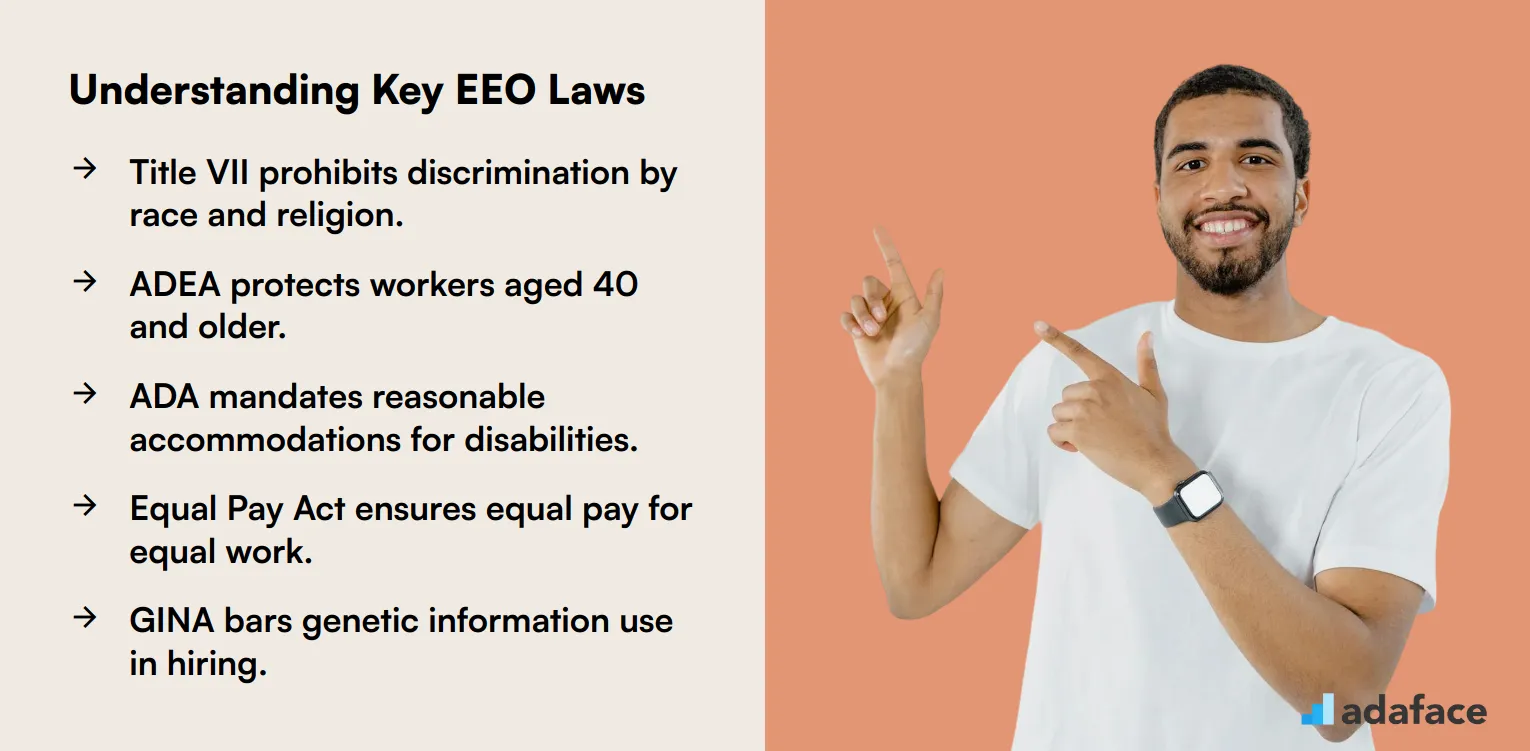EEO compliance is a critical aspect of the recruitment process, ensuring fair treatment for all candidates. It involves adhering to laws that prevent discrimination based on characteristics like race, gender, and age.
For recruiters, understanding EEO laws is key to avoiding legal pitfalls and promoting diversity. Implementing inclusive hiring practices can help create a more equitable workplace.
Table of contents
What is EEO Compliance?
EEO compliance refers to the adherence to laws and regulations that ensure equal employment opportunities for all individuals, regardless of race, color, religion, sex, or national origin. These laws are designed to prevent discrimination in the workplace and promote a diverse and inclusive environment.
For recruiters and hiring managers, understanding EEO compliance is crucial in creating fair hiring practices. It involves implementing strategies that eliminate bias and ensure all candidates are evaluated based on their qualifications rather than personal characteristics.
EEO compliance also requires organizations to maintain records and report on their employment practices to demonstrate their commitment to equal opportunity. This transparency helps build trust with potential employees and reinforces the company's dedication to diversity.
Incorporating EEO compliance into recruitment processes not only protects companies from legal issues but also enhances their reputation as fair and inclusive employers. This can be a significant advantage in attracting top talent who value workplace diversity and equality.
For those interested in learning more about recruitment strategies that align with EEO compliance, exploring inclusive hiring practices can provide valuable insights.
Key EEO Laws and Regulations
Equal Employment Opportunity (EEO) laws and regulations form the backbone of fair employment practices in the United States. These federal laws prohibit discrimination based on protected characteristics such as race, color, religion, sex, national origin, age, disability, and genetic information.
The Civil Rights Act of 1964, particularly Title VII, is a cornerstone of EEO legislation. It prohibits employment discrimination based on race, color, religion, sex, and national origin in companies with 15 or more employees.
The Age Discrimination in Employment Act (ADEA) of 1967 protects individuals who are 40 years of age or older from employment discrimination. This law applies to employers with 20 or more employees, including state and local governments.
The Americans with Disabilities Act (ADA) of 1990 prohibits discrimination against qualified individuals with disabilities. It requires employers to provide reasonable accommodations to employees with disabilities, unless doing so would cause undue hardship.
The Equal Pay Act of 1963 mandates that men and women in the same workplace be given equal pay for equal work. The jobs need not be identical, but they must be substantially equal.
The Genetic Information Nondiscrimination Act (GINA) of 2008 prohibits the use of genetic information in employment decisions. This law protects individuals from discrimination based on their genetic information in health insurance and employment.

Protected Classes in EEO
Protected classes in Equal Employment Opportunity (EEO) laws are specific groups shielded from discrimination in the workplace. These protections ensure that employment decisions are based on merit and not on personal characteristics unrelated to job performance.
The primary protected classes include race, color, religion, sex, and national origin, as outlined in the Civil Rights Act of 1964. Additionally, age, disability, and genetic information are protected under various other laws, ensuring a broad spectrum of coverage.
Employers must be vigilant in recognizing these classes to maintain compliance and foster an inclusive work environment. Missteps in this area can lead to legal challenges and damage to the company's reputation.
Understanding protected classes is not just about avoiding legal pitfalls; it's about promoting a diverse and equitable workplace. Acknowledging these protections is a step towards embracing diversity in the workplace and enhancing organizational culture.
Recruiters and hiring managers play a crucial role in upholding these standards during the recruitment process. By doing so, they contribute to a fair and dynamic workplace, benefiting both the employees and the organization.
EEO Compliance in Recruitment
EEO compliance in recruitment ensures a fair hiring process, promoting diversity and inclusion in the workplace. It involves adhering to regulations that prevent discrimination based on race, gender, age, or disability.
Recruiters and hiring managers must be aware of these guidelines to avoid unfair hiring practices. This awareness helps create a more equitable recruitment environment.
Implementing EEO compliance requires understanding the legal framework and its application in recruitment strategies. By doing so, organizations can foster a culture of diversity and equal opportunity.
Training and resources are available to help recruiters stay informed about EEO standards. These tools are crucial in maintaining a compliant and inclusive hiring process.
Regular audits and feedback loops can help ensure ongoing adherence to EEO principles. This proactive approach minimizes risks and enhances the organization's reputation as an equal opportunity employer.
Best Practices for EEO-Compliant Hiring
Ensuring EEO compliance in hiring involves adopting best practices that promote fairness and equality. Start by crafting job descriptions that focus on skills and qualifications, avoiding language that may deter diverse applicants.
Implement structured interviews to maintain consistency and fairness in the evaluation process. This approach helps minimize unconscious bias and ensures candidates are assessed on their abilities and experience.
Training interviewers on EEO principles and unconscious bias is crucial for fostering an inclusive hiring environment. This training should emphasize the importance of diversity and how to recognize and mitigate personal biases.
Regularly reviewing and updating recruitment policies ensures they align with EEO standards. This proactive approach helps identify potential areas of improvement and demonstrates a commitment to equal opportunity.
Collecting and analyzing recruitment data can provide insights into the effectiveness of your EEO compliance efforts. By understanding patterns and trends, organizations can make informed decisions to enhance their hiring practices.
Finally, fostering an open dialogue about diversity and inclusion within the workplace encourages a culture of acceptance and respect. This environment not only supports EEO compliance but also promotes a positive workplace culture.
Consequences of Non-Compliance
Non-compliance with EEO regulations can lead to severe consequences for organizations. These consequences range from financial penalties to damage to the company's reputation and legal action.
Financial penalties for EEO violations can be substantial, often reaching hundreds of thousands or even millions of dollars. The exact amount depends on factors such as the severity of the violation, the size of the company, and whether it's a repeat offense.
Legal action is another significant consequence of non-compliance. Employees or applicants who believe they've been discriminated against can file lawsuits, which can result in costly settlements or court-ordered damages.
Reputational damage is a less tangible but equally serious consequence of EEO non-compliance. Negative publicity surrounding discrimination cases can harm a company's image, making it harder to attract top talent and retain customers.
Regulatory bodies may also impose additional oversight on non-compliant companies. This can include mandatory training programs, regular audits, and increased reporting requirements, all of which can be time-consuming and costly.
In extreme cases, persistent non-compliance can lead to the loss of government contracts or even the closure of the business. It's crucial for organizations to prioritize EEO compliance to avoid these severe consequences.
Conclusion
Understanding EEO compliance is key for recruiters and hiring managers to foster an inclusive workplace. By adhering to these guidelines, you contribute to a fair and equitable hiring process.
Ignoring EEO laws can lead to serious consequences, including legal action and damage to your company's reputation. Stay informed and proactive to ensure your recruitment practices align with EEO standards.
By integrating EEO compliance into your hiring strategy, you not only protect your organization but also promote diversity and equality. Remember, a diverse workforce can drive innovation and success.
EEO Compliance FAQs
EEO compliance refers to following laws and regulations that prohibit workplace discrimination. It ensures equal opportunity for all candidates regardless of personal characteristics.
EEO compliance is crucial in recruitment to prevent discrimination, promote diversity, and avoid legal issues. It helps in creating a fair hiring process for all applicants.
Recruiters should be familiar with laws like the Civil Rights Act, the Age Discrimination in Employment Act, and the Americans with Disabilities Act, which protect against workplace discrimination.
Recruiters can ensure EEO compliance by implementing unbiased hiring practices, providing training, and regularly reviewing recruitment processes to align with legal standards.
Non-compliance with EEO laws can lead to legal action, financial penalties, and damage to an organization's reputation. It can also negatively impact workplace diversity.

40 min skill tests.
No trick questions.
Accurate shortlisting.
We make it easy for you to find the best candidates in your pipeline with a 40 min skills test.
Try for freeRelated terms



